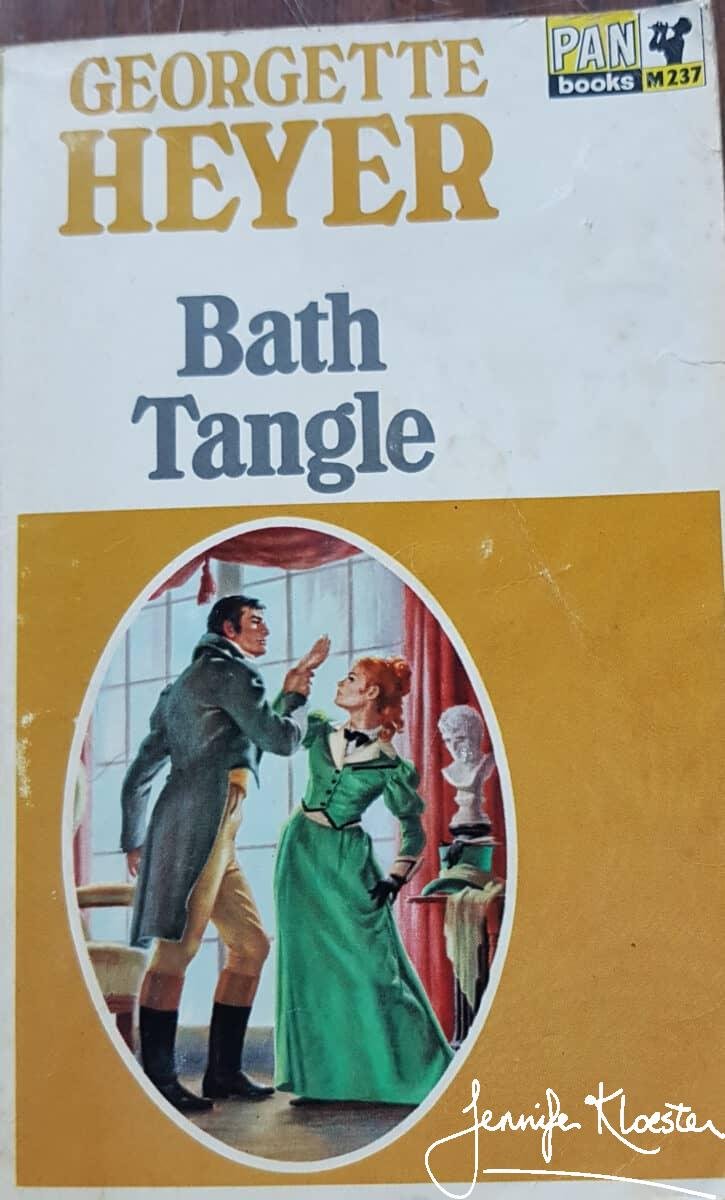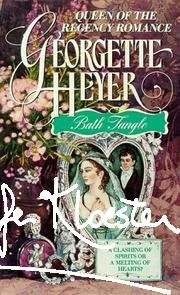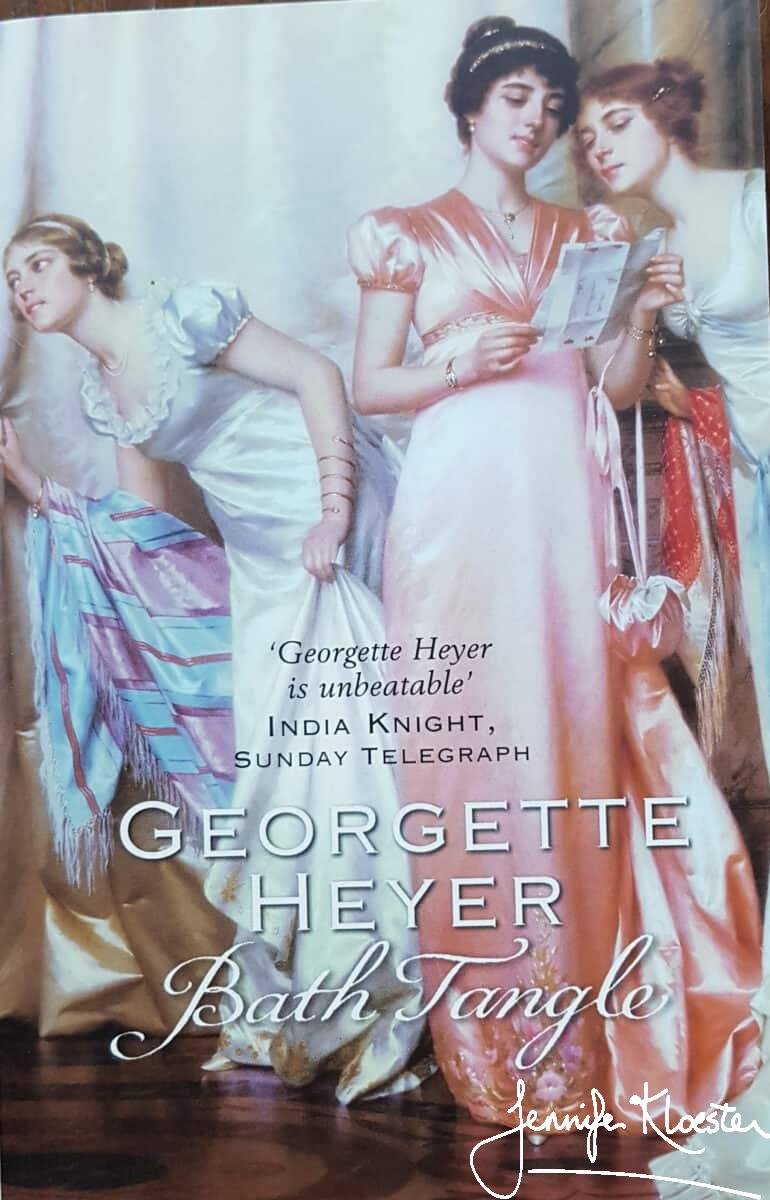“I had a run through Bath Tangle, and found it (like Old Mr Bronte) much better than likely”
Georgette Heyer to Louisa Callender, letter, 13 September 1954.

“a rough idea of the thing”
Georgette Heyer’s 41st novel, The Toll-Gate appeared on the bookstands in July 1954. Never one to rest on her laurels, she had already begun to evolve ideas for her next novel. Aware of the benefits of serialisation in Woman’s Journal in the months prior to her next book’s publication, on 4 July 1954, Georgette wrote to Louisa Callender at Heinemann to tell her about her plans for her new Regency novel. It was still in its early stages and the first chapters were, she confessed, “in a mess, and must be altered”. Georgette was always her own harshest critic and, reading the rest of her letter to Louisa, it is hard to believe that this negative assessment of her early chapters was accurate. In her usual inimitable style, she actually had the story well in hand and what she would call “a rough idea of the thing” would, in fact, be a remarkably accurate synopsis of the novel to come. As she told Louisa, in relation to letting the editor of Woman’s Journal, Dorothy Sutherland (the S.B.), know what she had in mind and in order to help the magazine’s illustrator, Georgette wrote:
I can, however, give her a rough idea of the thing – which I may well call Bath Tangle. It is all about the Lady Serena Carlow, only child of the Earl of Spenborough, deceased immediately before the book starts; and Ivo, Marquis of Rockingham, to whom she was once betrothed, with whom she quarrels on the smallest provocation, and who (to her wrath) is left Trustee to her fortune. He is very Heyer-hero. Opening chapter – in case the S.B. wants to set the artist to work at once – is at the Family Seat, Serena and her very young stepmother, Emily, discovered awaiting return of Funeral Party, for the reading of the Will. Serena, about 25, queenly, beautiful, and red-headed; Emily, a diaphanous and appealing blonde. (They have to be like that, so that each can look terrific in mourning. Emily, being a matron, would wear a cap, with black ribbons. Serena not.) Rockingham, tall, very dark and saturnine, very well-dressed, about 38-40. Also present, at the Reading, the said Marquis, the lawyer, the new Earl – a dim cousin – and Emily’s father, harassed. Probably others, but they’re still subject to change, and aren’t wanted in a picture. Serena, NOT having been informed of Rockingham’s trusteeship, is indignant – which would make a good picture. “You? My father cannot have been in the possession of his senses!” Well! – After a few months (glossed over) at the Dower House, Emily and Serena remove to Bath. Here, Serena meets the love of her youth, Major Hector Kirkby, a handsome, serious, and romantic type. They soon become engaged – before, in fact, the Major has realized that the gentle Emily is far more his type. Upon learning these tidings, Rockingham (an impulsive creature, one feels! He has an ill-governed temper, of course) announces his engagement to Miss Anne Laleham, a pretty nit-wit, whose slightly parvenu mother has been angling for him for months. But Rockingham has a tiresome and passionate ward, a young cousin (Gerard Monksleigh) who is – or fancies he is – madly in love with Anne. And Anne has a colossally wealthy, and wonderfully vulgar maternal grandmother, who lives in Bath – Mrs Prawle – who is going to play a large part. Also there is Mr Elphin, about whom I as yet know little, but who (I think) is going to nip Anne off under the noses of both her pretendants, with granny’s connivance. Mr Elphin, I fancy, is in Trade, but I haven’t met him yet. Yes, I know it stinks, but it won’t by the time I’ve done with it! My heroine has a lively sense of humour, and I can see some nice scenes blowing up. And – you’d never guess! – it all Ends Happily, with Serena marrying the disagreeable Ivo, and Emily the kind and considerate Hector, and Anne and Mr Elphin. At least— so I think at present!
Georgette Heyer to Louisa Callender, letter, 4 July 1954.

The 1968 Pan edition of Bath Tangle 
The 1971 Pan edition of Bath Tangle
Depth of character
Georgette’s enlightening account of her new novel proved to be remarkably accurate, although she did make some changes, mostly involving her characters’ names. Emily became Fanny; Anne became Emily (aka Emma), Mrs Prawle became Mrs Floore; Mr Elphin became Mr Goring, and most importantly of all, The Marquis of Rockingham became the Marquis of Rotherham. What does not appear in Heyer’s Bath Tangle synopsis is the depth of character which she achieved in the final book. There are elements of Shakespeare’s The Taming of the Shrew here, with a strong-minded heroine in the ironically named Serena, and a determined and devious Marquis in Ivo Barrasford. Each is highly intelligent, supremely confident and, to some extent, emotionally constrained. Each also has a temper and, like Katherina and Petruchio in the Shrew, Serena and Ivo (I love that their names also end in “a” and “o”) strike sparks off each other at almost every encounter. A few years earlier they had been engaged to be married until Serena “discovered him to be unendurable”. She creates a minor scandal by crying off from the marriage, but Serena and Ivo still manage to remain friends. Though they are quarrelsome and neither shies away from an argument, the two have much in common: they inhabit the same social world, share many interests – including politics and affairs of state – and they have a similar sense of humour. In short they are made for each other.

A clever tangle
That Ivo and Serena belong together is not clear at the outset, however, and Heyer creates a clever tangle in the novel of both people and emotions before their destiny becomes obvious – especially to Serena. Bath Tangle is a book replete with emotion and Heyer herself recognised it as a love-story rather than an adventure story. Her own concept of real love was not the romantical, idealised, fairy-tale variety, such as Fanny, Serena’s youthful mama-in-law, and Hector, Serena’s former lover and now fiancé, aspire to, rather Heyer believed that real love was based on friendship, honesty and mutual interest. This is what Georgette had with Ronald and, while she may have felt passion and experienced romantic love in her youth, she had long since concluded that that kind of worshipful love, blind adoration and idealistic romance were not the best basis for a long-lasting, meaningful relationship. There is a strong core of realism in Bath Tangle and Heyer does not shrink from depicting two very human people in Serena and Ivo. Indeed it is this that makes the novel well worth a close read.

No saint, Ivo
Ivo, the Marquis of Rotherham, is no saint and yet, although Serena has long since decided that she and Ivo will not suit, her father believed they belonged together. Consequently, Lord Spenborough made his will so that, at his death, Ivo should be named Trustee of Serena’s immense fortune with the power to withhold that fortune should she marry against his wishes. Heyer’s handling of this clichéd scenario is masterful and a close reading (or a keen listen to the new audiobook read by the excellent Poppy Gilbert) reveals two very human characters. Not all readers enjoy the flaring tempers in Bath Tangle, but Ivo and Serena are both realistic and they prove to be the perfect foils for the other, less assertive, characters in the novel with whom their lives become entangled. Georgette was well into writing Bath Tangle when she realised that she had misnamed her hero. Names mattered enormously to her because her characters formed the foundation of every book. She would spend hours playing patience or doing a complicated jigsaw (without a picture for guidance or even a straight border) while she worked out exactly who would populate her story. Because her characters lived for her, their names became an intrinsic part of their identity. Thus, to have to alter a character’s name midway through her story, was deeply disconcerting.
I’ve called my Heyer-Hero the Marquis of Rockingham, quite forgetting that very dim Prime Minister, who died in 1782 (I think) and was the second and last M. of R. It won’t do to use that title, and it cost me hours of thought and research to find another. Which probably sounds peculiar to you, even frivolous, but – you see – I don’t choose names lightly, and once named I can’t see a character under any other name! I tried to keep it as close as possible, but nothing in the style of Rockington, or Rockinghurst, “did” at all, and I’ve at last changed the gentleman’s title to Rotherham. I suppose I shall get used to it in time. He looks like a stranger to me at the moment.
Georgette Heyer to Louisa Callender, letter, 30 July 1954.

Heyer did not need to alter the Marquis’s Christian name, however, and it is likely her sense of humour that prompted her to name her hero Ivo. St Ivo of Kermartin was the patron saint of lawyers, judges, orphans and widows. One suspects that Georgette’s husband, Ronald, as her first reader, would have chuckled over the subtle reference, perhaps meant as a tribute to him and his achievements as a lawyer. The novel also contains a widow in Fanny and an orphan in Serena which makes the connection to St Ivo even more apposite! By the end of July 1954 Georgette had made substantial progress with the book and decided that “I rather think the fans are going to like it, though it isn’t adventurous”.
Georgette in Lady Serena Carlow?
For the knowing reader there are decided autobiographical elements in Bath Tangle. Like Serena, Georgette had also lost her father much too early. Though it was almost thirty years since George Heyer had died so suddenly, Georgette had never forgotten the father who had meant so much to her. Just as Lord Spenborough was friend and companion to his daughter, so too was George Heyer to Georgette. Years later she recalled that he had been “more like a brother than a father” and his death, so shockingly sudden on 16 June 1925, had delivered to Georgette a terrible blow from which she never fully recovered.
“The fact was that the dawdling life in Bath suited Serena no better than life at the Dower House. Mingled with the ache in her heart for the loss of one who had been more a companion than a father, was a restlessness, a yearning for she scarcely knew what, which found its relief in gallops over the surrounding countryside.”
Georgette Heyer, Bath Tangle, Pan, 1974, p.70.
Her father had returned home after playing tennis with her then-fiancé, Ronald, and had dropped dead in front of his beloved daughter. Two years later, when she finally began writing again, Georgette described a daughter’s suffering in her most autobiographical novel, Helen. Helen’s father has died suddenly and she is struck by “a grief so huge, so devastating” that it leaves her unable to speak about her loss. This was Heyer’s own reaction and one she depicts with real pathos in Bath Tangle. Never one to wear her heart on her sleeve, in her own life Georgette kept her deepest and most painful hurts to herself. Sylvia Gamble, who had been her secretary during the writing of An Infamous Army, later noted that neither she nor Georgette ever got over their respective father’s deaths. Georgette had talked a great deal about her father to Sylvia – something she was not inclined to do with many people – and it was clear that her father had meant the world to her and that his death had left a void in her life. The parallels between Georgette and Lady Serena Carlow in Bath Tangle are obvious and it is here, more than in any other of her historical novels, that Heyer’s own reaction to death and loss is so intimately articulated.
“I have not learned yet not to miss Papa. Don’t let us speak of that! You know how it is with me! I don’t care to talk of what so much affects me, and making a parade of grief is of all things the most repugnant to me.”
Georgette Heyer, Bath Tangle, Pan, 1974, p.82.

Comic brilliance
Though there is suffering in the novel there is also sparkling humour and comic brilliance and this especially well reflected in the character of Mrs Floore. Described by Jane Aiken Hodge as one of Heyer’s “best vulgarians” she steals the spotlight whenever she appears. Heyer loved writing these sorts of characters but she also shows, via Serena’s friendship with Mrs Floore and Rotherham’s keen interest in the lady, the true nature of class. Despite her aristocratic standing, Serena does not disdain Mrs Floore’s friendship but, liking the older woman and admiring her honesty and strength, appreciates her at her true value. There is a clear contrast in the novel between the supposed vulgarity of Mrs Floore (because of her “trade” background) and the real vulgarity of her far more aristocratic daughter, Lady Laleham. Like Austen, Heyer recognised the difference. Mrs Floore is a worthwhile person: honourable, honest, kind and caring, without airs or snobbery; Lady Laleham is the opposite – a snobbish social-climber who, for Georgette, epitomises the worst kind of vulgarity. Bath Tangle is a clever novel, which Heyer finished in just eight weeks! She was a true literary savant, with a genius for creating living, breathing characters and compelling plots, and Bath Tangle is a delightful read (or listen).
“In the newest of her Regency harlequinades, Bath Tangle, the indefatigable Georgette Heyer rings a variation on the familiar triangle. Instead of three lovelorn characters she uses three mixed-up couples who can’t get themselves sorted out till the last suspenseful pages”
A.F.W. “Funat the Spa” in Saturday Review, 3 September 1955, p.32.





2 thoughts on “Bath Tangle – “it all ends Happily””
Stupidly, the audiobook by Poppy Gilbert is region locked so I can’t get it. And I was so excited to try it!
Oh no, Jacob! That’s terrible – I didn’t think of regions when I recommended it. You’d think in this global world of ours that it wouldn’t matter any more. I do hope you enjoyed the article and I am sorry about the audio book. I’m hoping the new Penguin editions will have a worldwide release at some point. I will ask. Thanks for posting. Jen